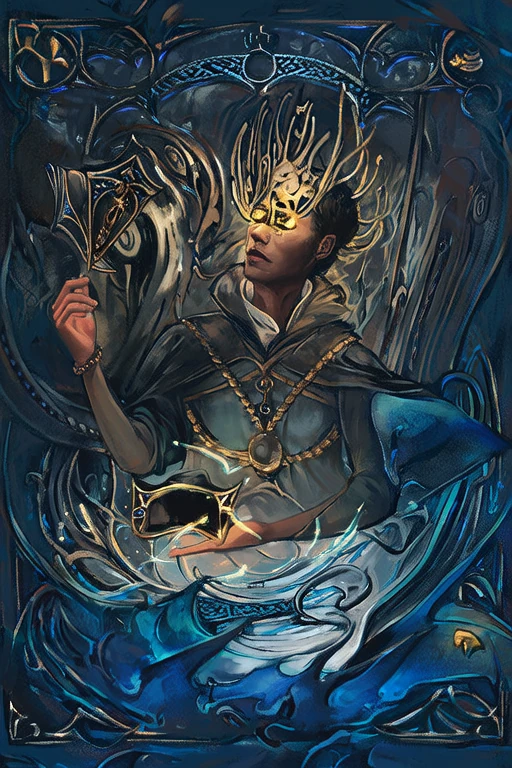
Ace of Cups
Discover the deep meaning of Ace of Cups with our free AI-powered tarot interpretation. Get instant, accurate readings based on advanced tarot knowledge.

Keywords
Upright Meaning
New feelings, spirituality, intuition
Reversed Meaning
Emotional loss, blocked creativity, emptiness
Full Interpretation
The Ace of Cups represents new emotional beginnings, spiritual awakening, and intuitive insights.
In-Depth Analysis
📜 Historical Background
The Ace of Cups, or 圣杯王牌 in Chinese, is the first card of the Cups suit in the Minor Arcana of the Tarot deck. Its origins trace back to early 15th-century Europe, where tarot cards were initially used for playing games before evolving into tools for divination and spiritual insight. The earliest known depiction of the Ace of Cups appears in the 15th-century Visconti-Sforza Tarot, a hand-painted deck from Italy. In this early version, the card features a simple chalice adorned with intricate designs, symbolizing the element of water and the emotional realm.
In medieval Europe, the cup or chalice held deep symbolic meaning, often associated with the Holy Grail in Christian mythology. The Grail was believed to be the vessel used by Jesus at the Last Supper and later used to collect his blood during the crucifixion. This mythological connection imbued the Ace of Cups with a sense of divine blessing, spiritual nourishment, and emotional fulfillment. In alchemical symbolism, the cup also represented the receptacle of the soul, reflecting the feminine principle and the power of intuition.
Over time, the imagery of the Ace of Cups evolved. The Rider-Waite-Smith deck (1909), which became the foundation for modern tarot, depicted the card as a single ornate cup overflowing with water, with five streams flowing outward. This imagery emphasized abundance, emotional overflow, and spiritual awakening. Other decks, such as the Thoth Tarot by Aleister Crowley and Lady Frieda Harris, infused the card with astrological and kabbalistic symbolism, linking it to the element of water and the sephirah of Yesod, representing the subconscious and emotional foundation.
Culturally, the Ace of Cups has been interpreted in various ways. In Eastern traditions, particularly in Chinese metaphysics, the card is associated with harmony, emotional balance, and the flow of qi or life force. The concept of yin energy, which governs receptivity, emotion, and nurturing, aligns closely with the card’s essence. In contrast, Western interpretations often focus on the psychological and spiritual dimensions of the card, emphasizing its role in emotional healing and intuitive development.
Throughout history, the Ace of Cups has remained a powerful symbol of emotional potential, spiritual connection, and the flow of divine grace. Its evolution reflects the changing cultural and mystical contexts in which tarot has been practiced, making it a timeless and deeply resonant archetype in the tarot tradition.
Symbolism & Imagery
The Ace of Cups is rich in symbolic meaning, with each visual element carefully chosen to convey its emotional and spiritual significance. At the heart of the card is the cup or chalice, a vessel traditionally associated with emotions, intuition, and the feminine principle. In many decks, the cup is depicted as ornate and overflowing, symbolizing abundance, emotional fulfillment, and the pouring forth of divine grace or inspiration.
The water flowing from the cup—often depicted as five streams in the Rider-Waite-Smith tradition—represents the manifestation of emotions into the physical world. These streams can symbolize the different aspects of emotional life, such as love, compassion, healing, creativity, and spiritual insight. The number five itself is significant in numerology, representing change, growth, and the human experience.
Color plays a crucial role in interpreting the Ace of Cups. The cup is often rendered in gold or silver, symbolizing spiritual wealth and emotional purity. Water is typically blue or clear, representing truth, clarity, and the subconscious mind. Some decks incorporate green or white backgrounds, which signify growth, harmony, and spiritual awakening. These color choices reinforce the card’s themes of emotional depth and spiritual nourishment.
Across cultures, the Ace of Cups resonates with various symbolic systems. In Western esoteric traditions, it corresponds to the element of water and is associated with the astrological signs of Cancer, Scorpio, and Pisces—water signs known for their emotional depth and intuitive nature. In Eastern metaphysics, particularly in Taoist and Chinese philosophy, the card aligns with the concept of yin energy, representing receptivity, fluidity, and emotional intelligence.
When the Ace of Cups appears upright in a reading, it signifies the beginning of an emotional or spiritual journey, often heralding love, healing, inspiration, or new opportunities for emotional growth. It suggests that the querent is open to receiving blessings and is in tune with their intuition. In the reversed position, the card may indicate emotional blockages, unexpressed feelings, or missed opportunities for connection. It can also warn against being overly sensitive or emotionally overwhelmed.
The Ace of Cups is closely connected to other cards in the Major and Minor Arcana. It shares thematic ties with the High Priestess, who governs intuition and the subconscious, and with the Two of Cups, which represents mutual emotional connection. In the Major Arcana, it resonates with the Empress, symbolizing nurturing, abundance, and creative potential. Together, these cards form a network of emotional and spiritual symbolism that enriches the interpretation of the Ace of Cups in any reading.
Psychological Insights
From a psychological perspective, the Ace of Cups can be understood through the lens of Carl Jung’s theory of archetypes and the collective unconscious. The card embodies the archetype of the Anima—the feminine aspect within the psyche that represents emotion, intuition, and the soul’s deeper wisdom. When the Ace of Cups appears in a reading, it often signals a call to reconnect with one’s inner emotional world, encouraging introspection, empathy, and self-compassion.
Modern life, with its fast pace and emphasis on logic and productivity, often leads individuals to suppress or neglect their emotional needs. The Ace of Cups serves as a reminder to honor and express emotions authentently. It encourages individuals to listen to their inner voice, trust their intuition, and open themselves to love, creativity, and spiritual inspiration. This card is particularly relevant for those experiencing emotional transitions, such as the beginning of a new relationship, the healing of past wounds, or the pursuit of creative endeavors.
In decision-making, the Ace of Cups suggests that the best choices are those made from a place of emotional clarity and inner alignment. Rather than relying solely on external logic or societal expectations, this card urges individuals to consider how a decision feels on a deeper level. It supports decisions that promote emotional well-being, authenticity, and meaningful connection.
For personal growth and self-awareness, the Ace of Cups invites individuals to explore their emotional patterns, understand their needs, and cultivate emotional intelligence. It encourages journaling, meditation, and creative expression as tools for emotional healing and self-discovery. Those who resonate with this card often find themselves drawn to helping professions, such as counseling, therapy, or holistic healing, where emotional sensitivity and empathy are valuable assets.
In therapeutic and counseling settings, the Ace of Cups can be a powerful tool for guiding clients toward emotional healing. It suggests that the client is ready to receive emotional support, whether through therapy, self-care practices, or meaningful relationships. The card also supports the use of creative therapies, such as art, music, or dance, as effective ways to process and express emotions.
In modern spiritual practices, the Ace of Cups is associated with rituals of emotional cleansing, intuitive development, and spiritual awakening. It is often used in meditation to open the heart chakra and connect with divine love and guidance. As a symbol of emotional abundance and spiritual grace, the Ace of Cups continues to offer profound insights and healing for those who seek its wisdom.
Correspondences
The Ace of Cups is deeply connected to the element of water, which governs emotions, intuition, and the subconscious mind. Astrologically, it is associated with the Moon, the celestial body that rules emotional tides, inner feelings, and psychic sensitivity. Additionally, the card aligns with the water signs of the zodiac—Cancer, Scorpio, and Pisces—all of which are known for their emotional depth, empathy, and spiritual attunement.
In terms of gemstones and crystals, the Ace of Cups resonates with stones that promote emotional healing and intuition. Moonstone enhances emotional balance and feminine energy, while Rose Quartz opens the heart to love and compassion. Amethyst supports spiritual insight and emotional clarity, and Aquamarine encourages calm and communication in emotional matters. These stones can be used in meditation or carried as talismans when working with the energy of the Ace of Cups.
Herbs and essential oils associated with the Ace of Cups include lavender for emotional calming, rose for love and emotional healing, chamomile for inner peace, and jasmine for spiritual awakening. Essential oils such as ylang-ylang, clary sage, and frankincense can be diffused or applied topically to enhance emotional receptivity and spiritual connection.
The Ace of Cups is linked to the season of winter, a time of introspection and emotional renewal. It is also associated with the evening hours, particularly twilight, when the veil between the physical and spiritual worlds is thin. As a water card, it corresponds to the west, the direction of endings, reflection, and emotional depth.
Energetically, the Ace of Cups is connected to the Heart Chakra (Anahata), the center of love, compassion, and emotional flow. It also resonates with the Sacral Chakra (Svadhisthana), which governs creativity, pleasure, and emotional expression. Balancing these chakras can help align with the card’s energy of emotional abundance and intuitive wisdom.
Numerologically, the number one (1) signifies new beginnings, independence, and the power of manifestation. As the first card of the Cups suit, the Ace of Cups represents the pure essence of emotional potential and the beginning of a heartfelt journey.
❓ Frequently Asked Questions
The Ace of Cups is a powerful and often emotionally resonant card in tarot readings, and it frequently raises questions among both beginners and experienced practitioners. One of the most common inquiries is: 'What does the Ace of Cups mean in a love reading?' In romantic contexts, the Ace of Cups typically signifies new love, emotional fulfillment, or a deepening of an existing relationship. It may indicate the arrival of a new partner or a renewed emotional connection with a current one. For those seeking love, it is a positive omen suggesting that emotional openness will lead to meaningful connections.
Another frequently asked question is: 'What does the Ace of Cups reversed mean in a reading?' When reversed, the Ace of Cups may point to emotional blockages, suppressed feelings, or difficulties in expressing love and compassion. It can suggest missed opportunities for emotional connection or a need to heal from past emotional wounds before being able to receive new blessings.
Beginners often misunderstand the Ace of Cups as solely representing romantic love, but its meaning extends beyond relationships to include emotional healing, creativity, intuition, and spiritual awakening. It is important to consider the surrounding cards and the querent’s personal context to determine the most accurate interpretation.
Professional readers use various techniques when working with the Ace of Cups. In a three-card spread, for example, it may represent the emotional foundation or the intuitive guidance available to the querent. In a Celtic Cross spread, the Ace of Cups in the center position can indicate that emotions are at the heart of the situation. Readers may also pair the Ace of Cups with cards like the Two of Cups to signify mutual emotional connection or with the Five of Cups to explore emotional disappointments.
How the Ace of Cups interacts with other cards can significantly influence its meaning. When paired with the Empress or the High Priestess, it reinforces themes of nurturing, intuition, and emotional depth. Conversely, when combined with the Five of Swords or the Three of Swords, it may suggest emotional conflicts or heartbreak that require healing.
Practical advice for interpreting the Ace of Cups involves paying attention to the querent’s emotional state and receptivity. Encourage reflection on how they are currently expressing or suppressing emotions. Remind them that the Ace of Cups is a gift of emotional potential—whether in love, creativity, or spiritual growth—and that embracing its energy can lead to profound transformation and inner harmony.
Practical Readings
Love Reading – Free • Online • AI • Instant • Accurate
In love, Ace of Cups upright: New feelings, spirituality, intuition. Reversed: Emotional loss, blocked creativity, emptiness.
Career Reading – Free • Online • AI • Instant • Accurate
For career, Ace of Cups upright: New feelings, spirituality, intuition. Reversed: Emotional loss, blocked creativity, emptiness.
Yes‑No Reading – Free • Online • AI • Instant • Accurate
As a quick yes‑no: upright tends toward “yes”, reversed leans “no”—interpret within your question’s context.
FAQ
What does Ace of Cups mean in tarot?
Ace of Cups represents new feelings, spirituality, intuition. This card encourages The Ace of Cups represents new emotional beginnings, spiritual awakening, and intuitive insights.
What is Ace of Cups reversed meaning?
When Ace of Cups appears reversed, it signifies emotional loss, blocked creativity, emptiness. Consider areas that may require adjustment or release.
Is Ace of Cups a positive card?
Ace of Cups is generally considered a neutral to positive card, representing new feelings, spirituality, intuition.
What should I do if I draw Ace of Cups?
If you draw Ace of Cups, focus on new feelings, spirituality, intuition. Align actions with the card’s upright energy.
How do I interpret Ace of Cups in a love reading?
In love readings, Ace of Cups suggests new feelings, spirituality, intuition in relationships. Consider how new feelings and spirituality apply to your situation.
What does Ace of Cups mean in a love reading?
In love, Ace of Cups points to new feelings, spirituality, intuition when upright and emotional loss, blocked creativity, emptiness reversed. Reflect on relational balance & authenticity.
How is Ace of Cups interpreted in career?
For career, Ace of Cups upright highlights new feelings, spirituality, intuition while reversed warns of emotional loss, blocked creativity, emptiness—adjust planning & execution.
What is the financial meaning of Ace of Cups?
Financially, Ace of Cups suggests new feelings, spirituality, intuition potential; reversed indicates emotional loss, blocked creativity, emptiness—use prudent pacing.
Is Ace of Cups a yes or no card?
Ace of Cups is generally a leaning YES when upright; reversed leans toward hesitation or NO—apply to the nuance of your question.
References
References
- Encyclopaedia Britannica – Tarot
Historical overview and cultural context of tarot cards.
- Wikipedia – Tarot
General reference on tarot history, structure, and usage.
- Biddy Tarot – Tarot Card Meanings
Widely cited interpretations and learning resources.
- Labyrinthos – Tarot Card Meanings
Educational articles on major and minor arcana.



